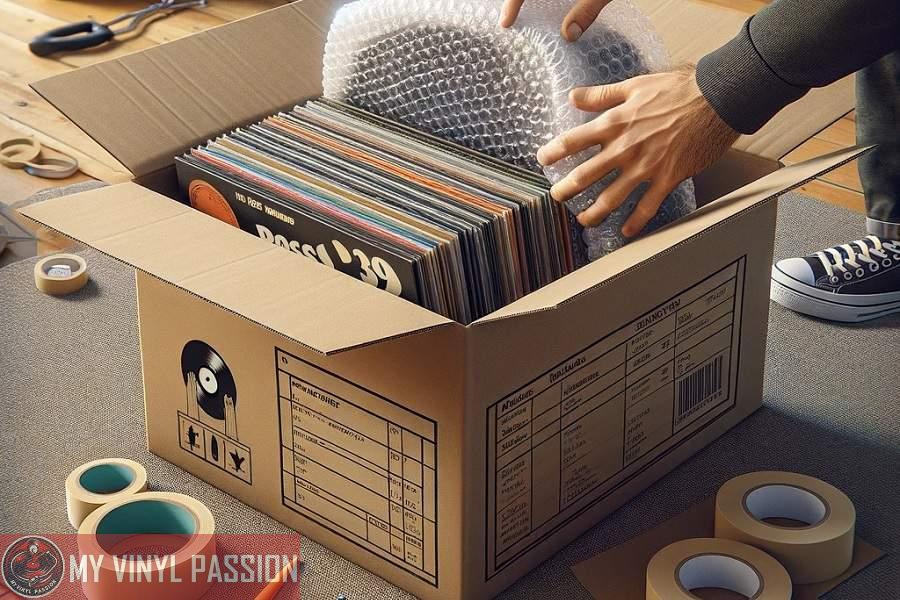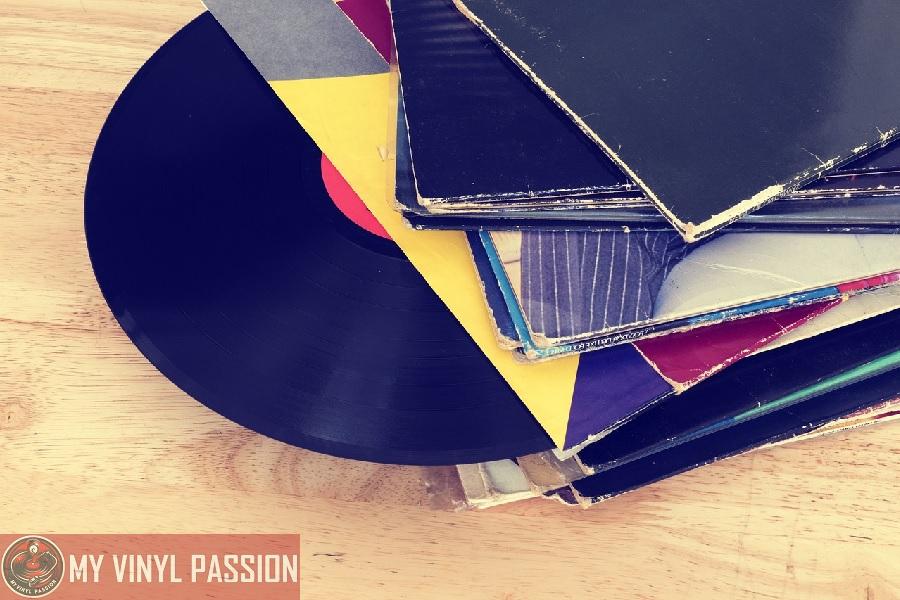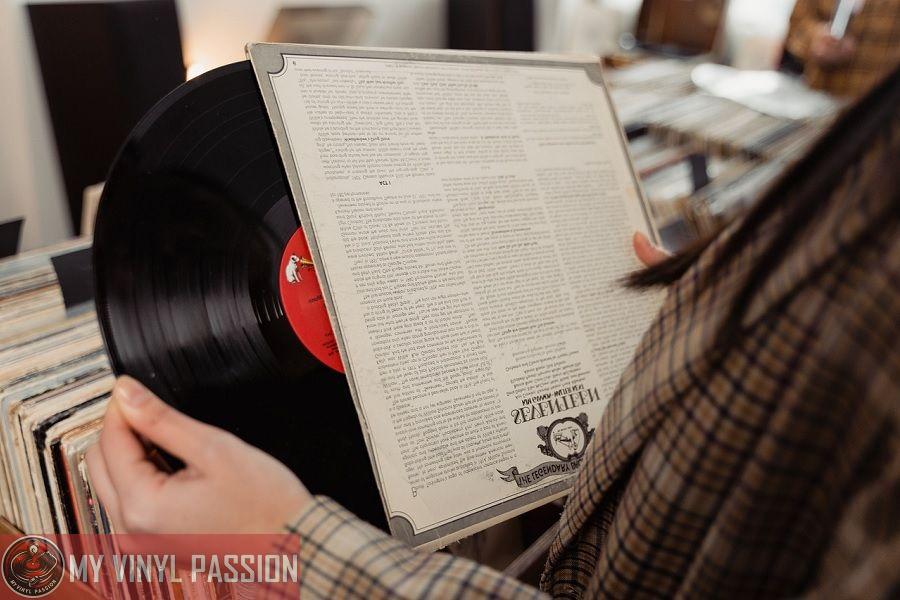Packing vinyl records for a move requires meticulousness to ensure your collection arrives without any damage.
Vinyl is susceptible to warping, scratching, and breaking if not handled correctly. Your records are not just music; they are also memories and possibly valuable collectibles, which makes it all the more important to pack them properly.
You want to make sure that each record and its sleeve are protected from the pressures and shifts that can occur during transportation.
In Summary
Choose strong, appropriately-sized boxes to ensure the vinyl records are snugly fit without excess space to prevent movement during transit.
Pack the records vertically side by side, like books on a shelf, to prevent warping and undue pressure on the vinyl surfaces.
Place each record in a protective sleeve or wrap them in bubble wrap to safeguard against scratches and dust.
Keep the records in a climate-controlled environment during the move, as extreme temperatures and humidity can cause warping or other damage.
Before you begin packing, gather the necessary materials such as sturdy boxes, plastic sleeves, bubble wrap, packing tape, and possibly cardboard inserts for additional support.
It’s vital to choose the right size boxes; they should be neither too large nor too small, as vinyl records should fit snugly to avoid excessive movement that can lead to damage.
When placing your records in boxes, keep them upright and side by side, similar to how you would store them on a shelf.
This position prevents unnecessary pressure on the vinyl and reduces the risk of warping. Ensuring there’s no space for the records to slide around in transit is key. If there is extra space, fill it with soft padding material.
Remember, your goal is to immobilize the records to minimize any movement while also avoiding overpacking, which can cause its own set of issues.
Preparing Your Vinyl Records
When you’re moving a vinyl record collection, it’s crucial to ensure that your records are clean, undamaged, and organized. This not only preserves the quality of the sound but also prevents any potential issues during transit.
Cleaning Records
Before packing, clean each record to remove dust and grime. Use a record brush to sweep away loose particles and then apply a vinyl-specific cleaning solution.
Wipe the records gently with a microfiber cloth in a circular motion, following the grooves. Ensure the records are completely dry before packing.
Inspecting for Damage
Examine your vinyl records for scratches or warps that can affect playback. Pay special attention to the edges and the center spindle hole, as damage here can cause tracking problems.
If any records are damaged, consider separate storage solutions to avoid harm to undamaged ones.
Organizing by Genre or Artist
To make unpacking easier, organize your collection by genre or artist before boxing them up. This helps in reducing the time you spend looking for specific albums later.
Create a simple list, or use a spreadsheet to track where each album is located within your packing boxes.
Selecting Packing Materials
When it comes to moving your vinyl records, selecting the right packing materials is critical to prevent damage during transport.
Choosing the Right Boxes
You’ll need sturdy boxes that can handle the weight of your records without bending or collapsing. Look for boxes that are slightly larger than the vinyl records themselves, providing enough room for additional padding. Ideally, choose boxes designed for records or ones with a strength rating suitable for the weight.
Inner and Outer Sleeves
Protect the records themselves by placing each in a poly inner sleeve, which will safeguard against scratches and dust. Then, slide the record in its inner sleeve into a cardboard album cover. Finally, for the best outer protection, place them inside plastic outer sleeves.
Opt for acid-free paper when choosing cardboard or paper sleeves to prevent chemical damage to the vinyl over time.
Additional Padding Options
To ensure the safety of your vinyl records, surround them with ample padding inside the box.
This can include bubble wrap and packing paper. Use the material to fill any voids, keeping the albums from shifting while in transit. Using layers of these padding materials will help absorb shock and prevent friction between albums.
Packing Vinyl Records Correctly
When moving your vinyl collection, the proper packing techniques are crucial to prevent damage such as warping or scratches.
Ensuring that each record and its jacket or outer sleeve is secured snugly within sturdy boxes can safeguard your valuable items throughout the move.
Placing Records into Sleeves
Firstly, place each of your vinyl records into its inner sleeve. If the original is not plastic-lined, consider acquiring anti-static sleeves to provide extra protection.
Slide the record into the inner sleeve, ensuring that the open edge of the sleeve is parallel to the top of the jacket to prevent dust accumulation. The record should then be placed into the outer sleeve or jacket, which reinforces the protection against potential scuffs or impacts.
Securing Albums in Boxes
Use sturdy boxes that are slightly larger than the size of your records when packing. You will want to pack the vinyl records vertically, as stacking them horizontally can exert too much pressure and lead to warping.
Arrange the albums in the box so they stand snugly against each other without being forced; the snug fit helps to prevent shifting. Between the albums, you may use bubble wrap or cardboard inserts for additional stability. Seal the box with packing tape, reinforcing the edges and seams for added security during transport.
Final Check Before Sealing
Before sealing the final box, do a quick final check to ensure everything is in order. Confirm that the records are upright, snug, and that the box isn’t overpacked.
The vinyl should not be pressing hard against the box sides — this is important to prevent jacket seams from splitting under pressure. Once checked, seal the box with packing tape and label it clearly, marking it as fragile to signify careful handling during the move.
Transporting Your Collection Safely
When moving your vinyl records, ensuring their safety is paramount. Proper transport methods prevent damage from heat, moisture, or mishandling.
Below, discover specific actions for safeguarding your collection throughout the moving process.
Loading into the Moving Truck
Choose a sturdy moving box that can hold the weight of your records, and pack them upright to avoid warping.
Ensure there is no excess space in the box, as records can shift and sustain damage. Use padding materials like bubble wrap or foam inserts for added stability. Load the boxes onto the moving truck carefully, placing them between stable items to prevent them from toppling or sliding.
Ensuring Climate Control
Extreme temperatures and high humidity levels can cause severe damage to vinyl records.
Keep them in a climate-controlled environment as much as possible. If the truck isn’t climate-controlled, opt for the shortest transport time, and keep them cool to prevent warping or melting. Avoid leaving the boxes near direct sunlight or in any spot that could become an oven during transport.
Handling with Care During Movement
Always handle the record boxes with care. Make sure the moving company is aware of the valuables they’re transporting.
If unpacking the records yourself, be gentle as you remove them from the moving boxes. Inspect each one post-move for any signs of damage, such as warping or scratches. If you notice any issues, it’s crucial to address them before they affect playback quality.
Unpacking and Storage
When your vinyl records arrive at their destination, the condition they are in often depends on how effectively you handle unpacking and storage. This process is vital to maintaining the quality of your collection.
Unpacking Records at Your New Location
When you unpack your records, handle each one with care to prevent damage. Remove records from their sleeves and boxes carefully and inspect each one for potential warping or scratches.
- Assess the Condition: As you unpack, check for any signs of damage that might have occurred during transit.
- Clean Your Records: Wipe away any dust that may have settled on your vinyl using a soft, anti-static cloth.
Long-Term Storage Solutions
For long-term storage, find a location in your home that is away from direct sunlight, as UV rays can deteriorate both the vinyl and the cover art. The ideal storage environment for your records is within a climate-controlled space, where the temperature is consistently between 65-70°F and the relative humidity is at 45-50%.
- Choose the Right Shelving: Use sturdy shelves that can bear the weight of your collection without sagging.
- Maintain Proper Organization: Store records vertically to avoid unnecessary pressure, which could lead to warping.
- Adequate Air Circulation: Ensure there’s enough room between records to promote air circulation, reducing the risk of mold growth.
FAQs
What is the best way to pack vinyl records for a move?
Pack vinyl records vertically in sturdy boxes, ensuring they are snug but not overly tight, and use padding materials like bubble wrap or packing paper for extra protection.
Should I remove vinyl records from their sleeves when packing?
No, keep the records in their protective sleeves to guard against scratches and dust. If possible, place additional protective inner sleeves for extra safety.
Can I stack vinyl records flat when moving them?
It’s not recommended to stack vinyl records flat, as this can cause warping and damage. Instead, store them vertically, like books on a shelf.
How can I prevent vinyl records from moving around inside the box?
Fill any empty spaces in the box with soft padding materials like bubble wrap, foam, or crumpled packing paper to prevent movement and cushion the records.
Is it necessary to consider temperature and humidity when moving vinyl records?
Yes, vinyl records are sensitive to extreme temperatures and humidity. Try to transport them in a climate-controlled environment and avoid leaving them in hot or damp conditions, like a car trunk, for extended periods.





